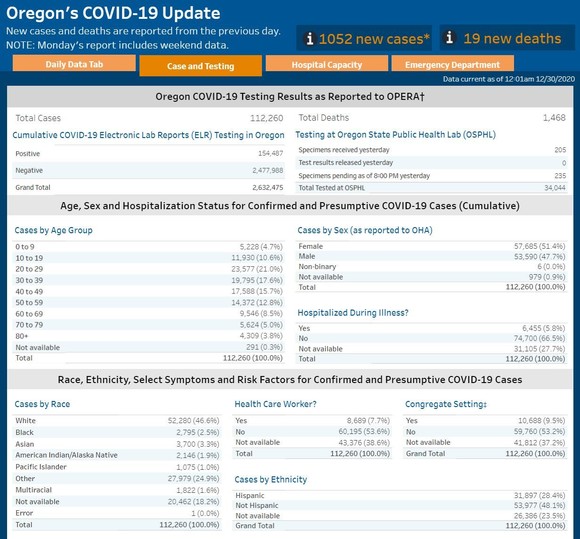|
Dear Friends and Neighbors,
I hope your holidays are going well and Happy New Year!
The holiday season can be a stressful time of year for many people, and this is our first time going through this stretch of winter during a pandemic. If you have loved ones or friends you haven’t spoken with in some time, consider giving them a call. You may not know when someone is struggling and needs support.
Additionally, I hope everyone will do the responsible thing for New Year’s Eve and avoid gathering in large groups. Oregonians did a good job of avoiding this over Thanksgiving, which helped our overall infection trend. And we need to keep it up!
If you entered this month concerned about yourself or someone you know losing their housing, I hope the Legislature’s action last week to extend the statewide eviction moratorium through June 30, 2021, eased some of the stress that so many are feeling as the pandemic continues.
It’s important for renters to understand the new law and protect themselves and their housing security. If you have questions about how the new statewide eviction ban works, please check out this explainer from the Oregon Law Center. It includes a version of the sworn declaration of financial hardship that renters must fill out, sign and give it to their landlords in order to be protected from eviction. If you live in Multnomah County, which has its own eviction protections in place, you can get more information here from Legal Aid Services of Oregon.
Additionally, this KGW story features an interview with Sybil Hebb of the Oregon Law Center and may answer some questions you or others have about the new law.
After a lot of uncertainty, it's great to finally see the passage of another federal relief package. We’re all still learning the details and timing of the assistance, but more help is on the way.
Federal unemployment benefits that were offered under the CARES Act that passed in March expired last Saturday. And because President Trump didn’t sign the latest bill until Sunday night, there was a concern that more than 70,000 Oregonians would experience a gap in these critical benefits.
The good news is that the Oregon Employment Department (OED) said that most Oregonians shouldn’t experience a benefits gap, as the Statesman Journal reported here.
The state is still waiting to receive rules and instructions from the U.S. Department of Labor before it can pay out benefits from the new federal relief bill. I will share more information on when these benefits will be available as soon as we know more. OED is planning a webinar to share more information next Thursday, January 7 at 1 p.m. You can register here.

The department says unemployed workers will NOT miss out on a week of PUA, PEUC, or FPUC benefits as a result of when the bill was signed. Those benefits will come retroactively once the department starts issuing payments.
Please continue filing your weekly claims, regardless of which program you are on.
Last week, Governor Brown announced that she was directing the Oregon Department of Education (ODE) and the Oregon Health Authority (OHA) to allow more local flexibility to decide when schools can reopen for in-person learning. The goal is to put more school districts on track to return students to in-person instruction by February 15, with a particular focus on elementary school students. Oregon Public Broadcasting has more on this decision here.
There have been immense challenges with distance learning, despite the heroic efforts of our educators and parents. Like a lot of folks, I’m concerned about the long-term consequences of this disruption in children’s education and social-emotional development.
Any return to the classroom, however, will have to be done safely and deliberately. Governor Brown has said educators, school staff members, and other school employees should be prioritized for vaccine distribution, as The Oregonian reported here. I think this is essential for a return to in-person learning, as well as improved access to on-site testing.
The Governor directed her agencies to review the Ready Schools, Safe Learners guidance to allow students the maximum access to in-person instruction while maintaining health and safety standards. That review will be completed by January 19.
On a national level, it’s concerning to see the pace of the vaccine rollout hampered by the limited federal resources dedicated to distribution. As this story notes, the federal government is going to fall short of their target of 20 million Americans vaccinated by the end of the year. This is certainly a monumental effort, but things need to move faster in order to establish herd immunity.
Locally, things have started more slowly than hoped. But progress is expected to pick up soon, and it’s still encouraging to see stories of Oregonians getting the vaccine, such as staff members and residents at nursing homes, where outbreaks have been a leading cause of deaths during the pandemic. The newer Moderna vaccine has been shipped to rural hospitals.
Oregon is the only state in the country where dentists can do vaccinations, thanks to legislation passed last year, and a Portland dentist recently became the first in the country to administer the COVID-19 vaccine.
As of Tuesday, the state had administered more than 20,000 vaccine doses. Oregon Public Broadcasting has more information here on who could be next in line to receive the vaccine.
This week Governor Brown updated the state’s County Risk Levels. Six counties moved from Extreme Risk down to High Risk. These levels will be effective from Friday, January 1 through Thursday, January 14. Please note there are no counties currently in the Moderate Risk category.
Lower Risk (7): Gilliam, Grant, Harney, Lake (moved from Moderate), Sherman, Wallowa, Wheeler
High Risk (6): Baker (moved from Extreme), Clatsop (moved from Extreme), Coos (moved from Extreme), Douglas (moved from Extreme), Lincoln (moved from Extreme), Morrow (moved from Extreme)
Extreme Risk (23): Benton, Clackamas, Columbia, Crook, Curry, Deschutes, Hood River, Jackson, Jefferson, Josephine, Klamath, Lane, Linn, Malheur, Marion, Multnomah, Polk, Tillamook, Umatilla, Union, Wasco, Washington, Yamhill
As a reminder, you can go here to see what activities are under each risk level.
While the situation remains critical, it’s been encouraging to see our hospitalization numbers improve over the last week, along with fewer cases and deaths. Data is showing the two-week freeze that was instituted last month helped flatten the curve. As Willamette Week reports here, state epidemiologist Dr. Dean Sidelinger credits Oregonians' willingness to follow public health guidance to our improved outcomes, particularly compared to other states. Thank you and keep it up!
Lastly, the Oregon Health Authority has created a new data dashboard that includes new cases, seven-day daily averages of cases, patients with COVID-19 who are currently hospitalized, test results reported, and new deaths. You can find the new dashboard on the OHA COVID-19 website. On the dropdown menus, click on “Daily Update.”

Oregon residents who lost access to water and sewer service through their private wells and septic systems due to the September wildfires can be considered for financial assistance under the Federal Emergency Management Agency (FEMA) Individuals and Households Program.
Residents in counties designated for federal assistance to individuals and households due to the 2020 wildfires (Clackamas, Douglas, Jackson, Klamath, Lane, Lincoln, Linn and Marion) may be eligible for a FEMA award for household repairs not usually covered by insurance. This includes repair or replacement of septic systems and wells damaged by wildfires.
To find out if you’re eligible, apply here, download the FEMA app, or call 800-621-3362 (TTY 800-462-7585).
Additionally, FEMA has begun construction in Mill City for temporary housing units to qualified survivor families from Linn and Marion counties. Once completed, the new site is expected to hold up to 16 temporary housing units.
FEMA’s Direct Housing mission is also in the process of providing transportable temporary housing to qualified disaster survivors in Jackson and Lincoln counties. To date, 47 Jackson County families have been placed in temporary housing units in commercial parks and at one group site – similar to the one now under construction in Mill City.
- The personal stories of those lost to COVID-19 are a good reminder of what’s at stake as we all do our part daily to fight this pandemic. Here are two pieces about Oregonians we’ve lost to the pandemic this year: this story from The Oregonian and this story from the Statesman Journal. Please keep the families of all who have died in your thoughts.
- The Centers for Disease Control and Prevention blames the increase in drug overdose deaths on the COVID-19 pandemic, including the 40% increase in Oregon, according to Oregon Public Broadcasting here.
- Flooding and landslides are still possible this winter following the Labor Day wildfires, as KLCC reports here.
- The Oregon Wildfire Recovery Debris Taskforce has announced new job opportunities during the cleanup process, as KOBI5 reports here.
- The Department of Motor Vehicles (DMV) will start issuing driver’s licenses to Oregonians regardless of their immigration status starting January 1, thanks to the passage of House Bill 2015 in the 2019 session. The Oregonian has more details here.
- Also, starting January 1, pharmacies in Oregon will be required to provide labels in multiple languages for prescription bottles, Think Out Loud reports here.
- Yesterday, the Oregon Health Authority reported 1,052 new confirmed cases of coronavirus, bringing the statewide total of new and presumptive cases to 112,260. The OHA also reported 19 more deaths, meaning 1,468 Oregonians have died of the coronavirus. You can click the images below for links to interactive data tables about coronavirus in Oregon.



To read past newsletters, you can go to this link. For up to date information, please check this link to the Oregon Health Authority where regular updates are posted: https://www.oregon.gov/oha/ERD/Pages/News-Releases.aspx
Please email me at Rep.TinaKotek@oregonlegislature.gov if you have specific concerns that have not been addressed by the OHA. Our office will do all we can to help and protect all Oregonians.
Thank you for reading! We will get through this together.
Best,

Tina Kotek
State Representative
House District 44
Speaker of the House
email: Rep.TinaKotek@oregonlegislature.gov I phone: 503-986-1200
address: 900 Court St NE, H-269, Salem, OR 97301
website: http://www.oregonlegislature.gov/kotek
|